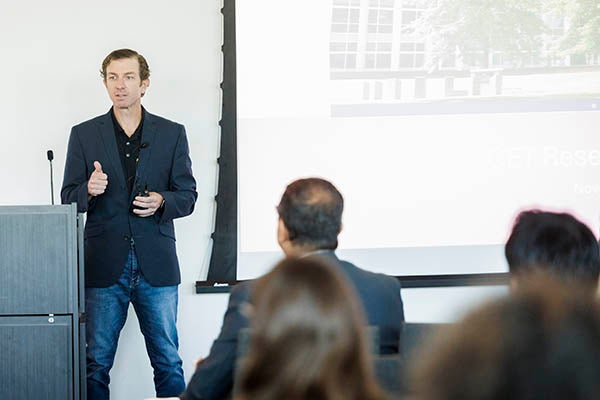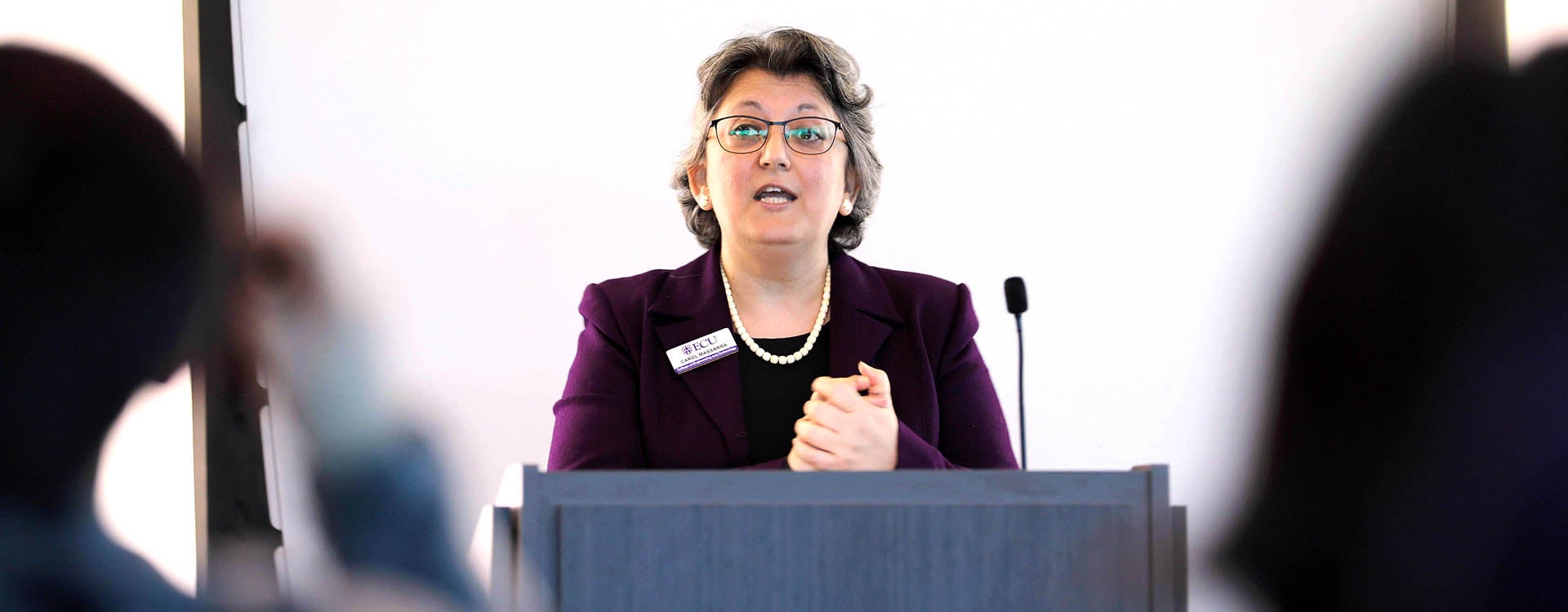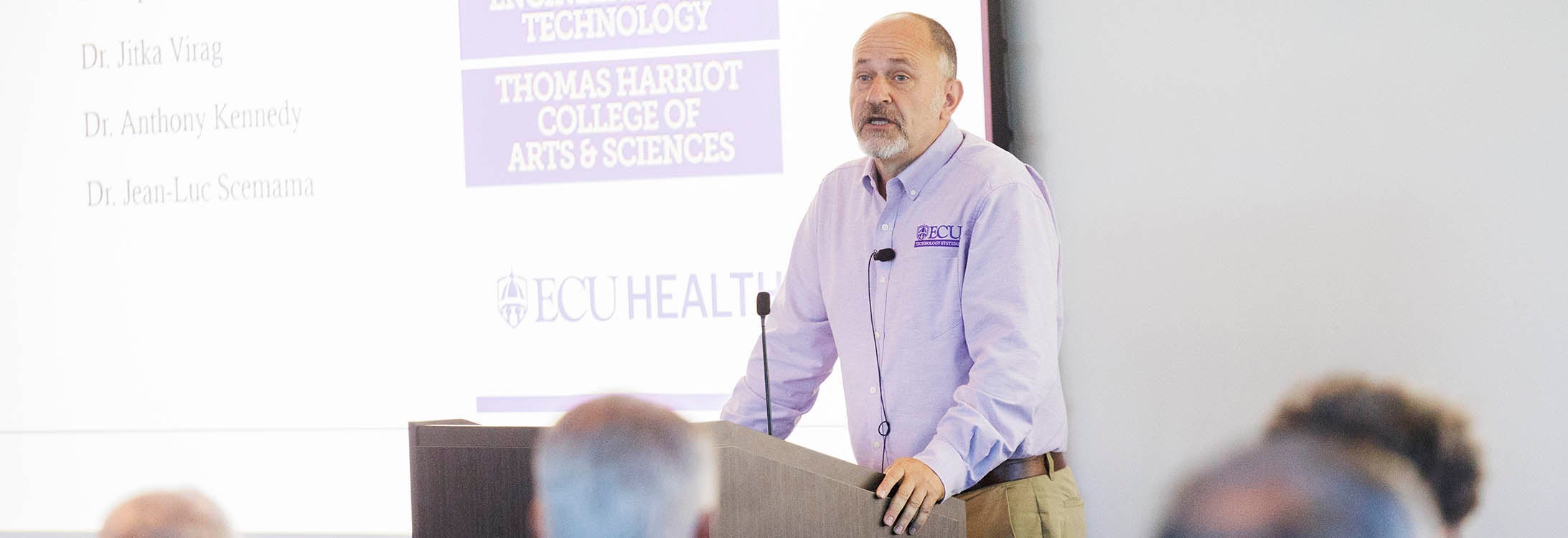Research showcase highlights projects that support the military
Researchers in the East Carolina University College of Engineering and Technology (CET) highlighted their work on military projects that can save lives and save money as part of the CET Research Showcase in the Main Campus Student Center.
Dr. Harry Ploehn, dean of the College of Engineering and Technology, said the event celebrated research collaboration. He said when expert faculty members from across campus team with the military and bring in students hungry for real-world experiences, problems will be solved.
“If we do those three things well, then good things are going to happen, both for our partners who need solutions to their problems and for our faculty and for our students,” Ploehn told a room full of ECU faculty and students, military representatives and legislative officials.
Since 2022, CET faculty have secured nine grants totaling $4.1 million from the Civil Military Innovation Institute (CMI2), a nonprofit designed to provide quick and effective solutions to support warfighters.
“The one thing we’re trying to address with the catalyst pathfinder program is being able to solve problems at the lowest level, so soldier-driven innovation, with a quick response,” said Ben Borger, CMI2’s warfighter innovation chief at Fort Liberty. “We can solve problems together.”
The projects discussed during the showcase highlighted collaboration among various departments within CET as well as faculty from outside of the college. As an example, Dr. Ciprian Popoviciu, assistant professor in the Department of Technology Systems, is working with professors in physiology, chemistry and biology to assess the quality of whole blood that is airdropped to help service members wounded in battle.
“To have the opportunity to help in any small way the people who are in the battlefield, who are risking their lives, it is truly not only an honor, but such an exciting thing, such a driver for us to do a great job,” Popoviciu said.
He explained that many factors can impact the quality of blood as it is airdropped, including impact with the ground, height at which the blood is dropped, air pressure and temperature. As part of the work, the team used sensors to gather data on airdropped blood.
“We think it’s very important work to put together a very clear formula that will tell you at which point we would have concerns about the viability of the dropped blood,” Popoviciu said. “… We want to have a solution for the warfighter.”
As part of the project, the team traveled to Fort Liberty to meet with Army personnel and airdropped several boxes to gather data for the project.
“Our team was so impressed with the soldiers who helped make this happen,” Popoviciu said. “They’re extremely passionate and extremely smart. They constantly had very good ideas and wrapped up this project into such a nice experience, with us providing some knowledge and some of our experience toward making a true difference in someone’s life.”
Dr. Carol Massarra, assistant professor in the Department of Construction Management, collaborated with computer science and technology systems on a project to support building maintenance solutions.
“We can use the historical data that is already available and the data collected from the data sensors to develop a predictive model so they can predict what maintenance they need and when the components will fail based on scientific work,” Massarra said. “(If) they can predict before the failure of the component happens, they could save money.”

Ben Borger, Civil Military Innovation Institute warfighter innovation chief at Fort Liberty, speaks during the showcase. (Photo by Steven Mantilla)
Massarra said the project serves a bigger purpose and can help others.
“It’s important to give back to people, so this is one way to do that,” she said. “… We’re finding a solution to a problem that exists in the community, and I think that’s very rewarding for us to be able to help.”
Dr. Randall Etheridge, associate professor in the Department of Engineering, is spearheading an effort to improve sustainability and ecosystems through managed plant systems at Fort Liberty. Not only could the project benefit the environment, but it could also affect warfighter training.
“You may be wondering what the connection is between plants and training. Maintaining plants and maintaining lawns takes time away from training. That’s what our project is really focused on,” he said. “Can we restore native vegetation to traditional lawn areas? They have hundreds of acres that they’re responsible for mowing, so we’re looking into the possibility of restoring that for the ecosystem that the native vegetation provides. And then what are the savings from a standpoint of training time, gas, carbon dioxide emissions?”
Dr. Erol Ozan, associate professor in the Department of Technology Systems, has worked with nine ECU students on a project to develop a new database system for the Army’s 82nd Airborne Division. He pointed out that the students who worked on the project are roughly the same age as the personnel using the system, so their input was especially relevant.
“They get experience with a real-life problem with real product development with a real client, and it’s beneficial for the country, so it’s perfect,” Ozan said of the students.
Keith Wheeler, the executive director of national security and industry initiatives in ECU’s Office of Innovation and Engagement, and Jim Menke, ECU’s director of national security initiatives, work to encourage faculty to consider CMI2 projects. Not only do the projects benefit the military, but they believe the work can help students consider career paths with the Department of Defense (DoD), just one more added benefit to the program.
“You can see the impact that it’s making, not just for faculty but for students,” Wheeler said of the projects. “That is huge in the DoD world. We need a lot more of the next generation getting involved and understanding that they can work on these types of projects.”

Dr. Carol Massarra, assistant professor in the Department of Construction Management, speaks about a project to provide the Army a predictive building maintenance model during the CET Research Showcase. (Photo by Ken Buday)
